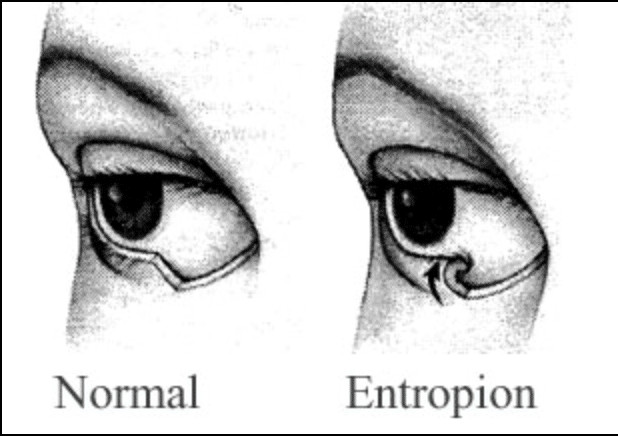Words
Published

Symptoms of Entropion
Even one eyelash poking into your eye causes a foreign body sensation. A whole row of ingrown eyelashes causes severe and chronic discomfort. Symptoms include:- Foreign body sensation (feeling there is something in your eye)
- Redness
- Pain – often acute
- Watering
- Discharge collecting in the inner corners of the eyes
- Ulcers, caused by bacteria entering the eye’s delicate tissues through trauma sites on the surface (which can result in decreased vision and permanent scarring)
- Sagging skin around the eyes
- Sensitivity to wind and bright light
- Dry eye symptoms
Causes of Entropion
- Age-related changes to the skin around the eyes.
- East-Asian race is also a risk factor, as the eyelid margins can be prone to turning in, even in children.
- Scarring from burns and other trauma to the face
- Trachoma (an eye infection that can cause scarring of the eyelids)
- Congenital factors, e.g. some syndromes and epiblepharon (see below).
Treatment of Entropion
Mild, age-related cases of the disease, which only effect a small section of the eyelid can be managed with periodic removal of the eyelashes. This can be done by your optometrist or GP. Chronic disease, involving a large section of the eyelid, is managed with surgery. The goal of surgery is not only to relieve symptoms but to prevent permanent damage (scarring) to your cornea. During surgery, some of the eyelid skin is removed and the underlying muscles and tendons may be shortened, which pulls the lid margin away from the cornea. A couple of stitches are required. The procedure may be done under local anaesthetic or sedation, depending on the surgeon. Provided surgery takes place before any corneal scarring occurs, prognosis is excellent.Trichiasis, Epiblepharon or Entropion?
- In Trichiasis, the eyelids are correctly aligned, but the eyelashes are abnormally positioned and grow back into the eye. It is often caused by trachoma scarring, and is the leading cause of infectious blindness in the world.
- Epiblepharon is a little different again; this time the eyelashes and eyelid margins are both normal anatomically but the eyelid itself has an extra fold of skin which has the effect of rolling the eyelid margins inwards. It can usually be corrected by a minor surgical procedure or may require no treatment.

